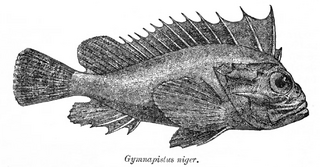
Mackerel is a common name applied to a number of different species of pelagic fish, mostly from the family Scombridae. They are found in both temperate and tropical seas, mostly living along the coast or offshore in the oceanic environment.
A dace is a small fish that can be one of many different species. The unmodified name is usually a reference to the common dace. This, like most fish called "daces", belongs to the family Cyprinidae, mostly in subfamily Leuciscinae.

The northern bastard codling is a morid cod of the genus Pseudophycis, found around southern Australia including Tasmania, and New Zealand, from the surface to 220 m. Its length is between 15 and 25 cm.

The southern bastard codling or bearded red cod is a morid cod of the genus Pseudophycis, found around southern Australia including Tasmania, and New Zealand, from the surface to 300 m. Its length is up to 63 cm.

The red codling or hoka is a morid cod of the genus Pseudophycis, restricted to New Zealand, from the surface to 700 m. A closely related species, Pseudophycis barbata, is found in Australia. It reaches lengths up to 90 cm. P. bachus is a food source for the diving yellow-eyed penguin, Megadyptes antipodes.

Pseudophycis is a genus of codlings of the family Moridae found around New Zealand and Southern Australia.

Scorpaenopsis is a genus of marine ray-finned fish belonging to the family Scorpaenidae, the scorpionfishes. The fishes in this genus are found in the Indian and Pacific Ocean.
Microcambeva is a genus of catfishes of the family Trichomycteridae.

Zacco is a genus of small ray-finned fishes in the family Cyprinidae. They are found in freshwater habitats in China and northern Vietnam. The generic name Zacco derives from the Japanese Zako雑魚.

Algansea is a genus of ray-finned fish in the family Leuciscidae, distributed in the Lerma–Chapala–Grande de Santiago, Pátzcuaro, Armería, Ameca, Ayutla and Tuxpan basins in west-central Mexico. The genus includes both species that are locally numerous, and species that are highly threatened. Their closest relative is the longfin dace.
The Lerma chub is a species of freshwater fish in the family Cyprinidae. It is endemic to the uppermost Lerma River basin in the State of Mexico and Toluca Valley of central Mexico. This threatened species is up to about 13 cm (5.1 in) long.

Candidia is a genus of freshwater ray-finned fishes belonging to the family Xenocyprididae. This is a small genus with two valid species, all of which are endemic to Taiwan.

Brotula is a genus of cusk-eels. It is the only genus in the subfamily Brotulinae.

The tubenose poacher is a species of poacher native to the northern Pacific Ocean. This species occurs at depths of from 0 to 105 metres. This species grows to a length of 17 centimetres (6.7 in) TL. This species is the only known member of its genus.

Tetraroge is a genus of ray-finned fishes, waspfishes belonging to the subfamily Tetraroginae, which is classified as part of the family Scorpaenidae, the scorpionfishes and their relatives. These fishes are native to the Indian Ocean and the western Pacific Ocean.
Madhuca barbata is a plant in the family Sapotaceae. The specific epithet barbata means 'bearded', referring to the sepals.

Scorpaenopsis barbata, the bearded scorpionfish, is a species of venomous marine ray-finned fish belonging to the family Scorpaenidae, the scorpionfishes. This species is found in the Indian and Pacific Oceans.

Brotula barbata, commonly known as the bearded brotula, Atlantic bearded brotula, or sugarfish, is a species of cusk-eel in the genus Brotula. It lives in the Atlantic Ocean, in depths of up to 300 meters. Its coloring ranges from olive-brown to red-brown, and it grows up to be around 50 centimeters. It has a carnivorous diet, and it is oviparous.

Acanthaphritis is a genus of ray-finned fish which are part of the family Hemerocoetidae. They have an Indo-Pacific distribution.

Brotula barbata, commonly known as the goatsbeard brotula, is a species of cusk-eel in the genus Brotula. It lives in the Indo-Pacific, in depths of up to 300 meters. It is dark brown with a submarginal black band and narrow white border on the dorsal and anal fins versus greenish to orange brown with orange-bordered dorsal and anal fins, and it grows up to be around 100 centimeters. It has a carnivorous diet, and it is oviparous.














